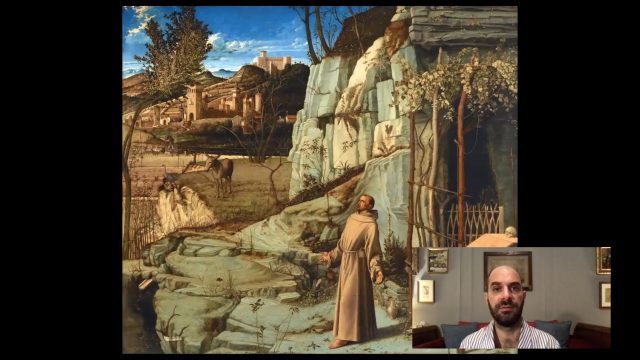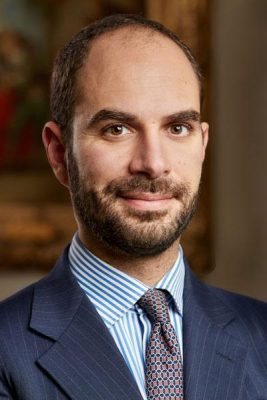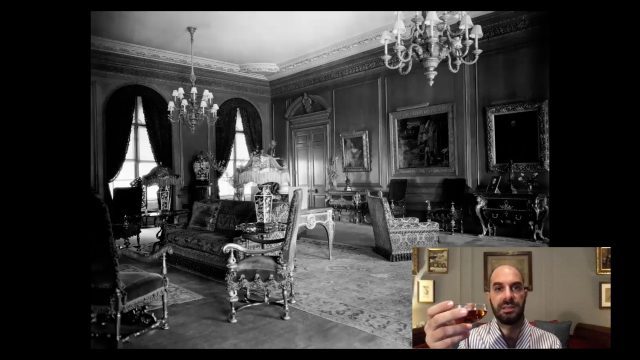
Frick Chief Curator Xavier F. Salomon chose a Manhattan to drink while exploring Bellini’s St. Francis in the Desert from home (courtesy the Frick Collection)
The Frick Collection
Travels with a Curator: Wednesdays at 5:00, free
Cocktails with a Curator: Fridays at 5:00, free
www.frick.org
Among the things that many of us are missing the most during the Covid-19 crisis are art and travel. They might not be essential businesses, but they’re key parts of a full and rewarding life. Both serve as respites from the everyday; they entertain and educate us, offering escape from our daily toil. “How Can We Think of Art at a Time Like This?” is the titular question of Barbara Pollack and Anne Verhallen’s ongoing online exhibition, which features new and recent work from major living artists addressing the pandemic and politics. The answer, of course, is how can we not?
Xavier F. Salomon has found his own unique method of thinking about art in the time of coronavirus, adding related travel as well. Salomon, who was born in Rome to an English mother and a Danish father, was raised in Italy and England, and received his BA, MA, and PhD from the Courtauld Institute of Art in London, is the Peter Jay Sharp Chief Curator at the Frick Collection. Every Wednesday and Friday, he takes over the Frick’s YouTube channel with deep dives into art history. On Wednesday’s “Travels with a Curator,” Salomon, who previously worked at the British Museum, the National Gallery and the Dulwich Picture Gallery in London, and the Met here in New York — quite a resume for a man only just in his forties — gives an illustrated lecture about art and architecture in specific cities; so far he has guided us through Castel Sant’Angelo, Rome, and Ca’ d’Oro, Venice.

Frick Chief Curator Xavier F. Salomon is becoming an internet star during pandemic (photo by Michael Bodycomb)
He is fast becoming an internet superstar for his Friday talks, “Cocktails with a Curator,” my preferred manner of ending the workweek. At 5:00, Salomon pairs a masterpiece from the Frick with a cocktail and spends between fifteen and twenty minutes discussing the Frick gem and the drink, placing them in context of the current pandemic. Seen in the lower-right-hand corner of the screen, the bald, bearded, handsome, and ever-charming Salomon has helped us look deeply into Rembrandt’s Polish Rider with a Szarlotka, Bellini’s St. Francis in the Desert with a Manhattan, and Van Dyck’s Sir John Suckling with a Pink Gin. (On May 1, curator Aimee Ng explored Constable’s White Horse with a gin and Dubonnet.)
On May 8, Salomon will visit with Joseph Mallord William Turner’s Harbor of Dieppe: Changement de Domicile while enjoying a Widow’s Kiss. (The recipes, which include alcohol-free versions, are posted on the YouTube page in advance.) The Frick is my personal favorite museum, a place I go to often to see familiar works that both relax and energize me — including Harbor of Dieppe, which I’ve marveled at on many occasions — so I’m finding these talks, which are prerecorded but stream live (and can be also watched later), absolutely essential in every way. Salomon recently took a break from his art history forays to discuss art and travel in the age of coronavirus.
twi-ny: Last year, before the pandemic, you started examining specific works from current Frick special exhibitions in a Facebook series called “Live from the Frick!” How did that evolve into “Cocktails with a Curator”?
xavier f. salomon: The Frick Collection has had a long tradition of online offerings (exhibition virtual tours, online live streaming of scholarly lectures, and Facebook “Lives,” among many examples). As soon as the lockdown began, we started to think, as a team, as to what we could offer to as varied an audience as possible. The idea of weekly appointments – with “Cocktails” on Fridays and “Travels” on Wednesdays – is designed to take our minds away from our current problems and to “meet” virtually. The idea was to match art with something we may miss from our previous life: things such as going out with friends for a drink, or traveling.
twi-ny: Do you consider yourself a cocktail aficionado? Are you trying new drinks, or are you choosing some of your favorites?
xaf: I do like cocktails very much. I am starting with a number of favorites, but as the series will continue, I am definitely planning to explore new options.
twi-ny: As a Frick regular, I feel that many of the paintings and sculptures in the museum are like old friends and members of the family that I thought I knew so well. I’ve stared at “St. Francis in the Desert” dozens of times, but as I watched your description on “Cocktails,” I felt as if I’d never really seen it. Because you are presenting this with a slightly adjusted context, referencing the pandemic, do you find yourself learning surprising things about works that you thought you knew so well?
xaf: The Frick is a museum of masterpieces. And I always believed that great works of art, first of all, can improve our lives but can also mean a number of different things at different times. One of the most common questions I have been asked in the last few years is: “Are works of art by Old Masters relevant?” The answer is: “YES!!!” And I hope to demonstrate this with this series. One thing that this virus is making apparent to everyone is how fragile human beings are. Artworks are the best that human beings have produced in the last few thousand years, and they can help us understand why and how we live. People a thousand years ago, five hundred years ago, a hundred years ago, were dealing with life as we do, with love, with friendship, with knowledge, with financial issues . . . and with epidemics and death. So I have been working on matching works at the Frick with broad issues we are thinking about today. And – not surprisingly – it is actually quite easy. And I am enjoying thinking about our works in this way.
twi-ny: I’m also appreciative of how fresh your analysis is. In the most recent Frick Collection magazine, you wrote about van Dyck’s “Sir John Suckling,” but your “Cocktails” talk about it explored the painting differently. I gather you would agree that “perspective is everything”?
xaf: Yes, I fully agree. And that is the importance of great works of art. They can be understood in a number of ways and can touch different chords in us. The same work of art meant different things to me when I was a teenager, or ten years ago. . . . We change as we go through life, and a truly great masterpiece can be for us a travel companion or a great friend. We change and they alongside us.
twi-ny: The camerawork is extraordinary, taking us deep inside the paintings. Is that footage already available, or might someone be taking new shots inside the museum?
xaf: The Frick has always had an in-house photographer, and our works have been very well photographed over the years by very talented people. All of the photographs of our works are from our archives. No new photography has been commissioned for these online programs. And many of the photos of locations I have taken myself over the years on my travels.
twi-ny: For the third “Cocktails” presentation, you cleverly changed where you were sitting when giving the talks. What part of the city are you sequestered in, and are you sheltering in place with any humans or animals?
xaf: I have been playing with different corners of my apartment to find an ideal location for the filming. It is a first for me, to film myself in my own apartment. I live in Washington Heights, in Manhattan, an area I like very much. I am, unfortunately, sheltering in place alone, as my partner (in the same situation) is across the Atlantic, in Europe. I would love to have a pet, especially during these times. But I cannot complain, because in my “hermitage” at least I have books.

Xavier F. Salomon brings the Frick into his home and ours in weekly online series (courtesy the Frick Collection)
twi-ny: Most curators exist in the background; the public might read essays by them in catalogs and wall text, or maybe see them if they go to an illustrated lecture at a museum. But you’re becoming a virtual sensation, with fans tuning in not just to hear about a masterpiece but to specifically see you and have a drink together. How does that feel?
xaf: I am not sure I would describe myself as a “virtual sensation.” But I also don’t believe that curators or art historians should live in the “background.” Art is for everyone, and if people want to know more about museums or works of art, curators need to be accessible. It is not about spending our lives in ivory towers and being buried in our libraries or our museums. As much as many of us (myself included) don’t necessarily dislike that idea, there is the fundamental fact that we need to put our knowledge and studies somewhere out there and have it available for the general public. I am not looking for fans, but I have to confess that it feels very rewarding to know that, with a very small contribution, I have somewhat enhanced people’s lives at a particularly difficult time.
twi-ny: You appear to love what you do, and you can be very funny, but on camera you never break character as a serious art historian. What does it take to make you burst out laughing?
xaf: I love, adore, what I do. I live for it. I could not imagine doing anything else with my life. I don’t know why, but I always feel awkward when laughing in public. But many things make me laugh out loud, and, it is usually female comedians. Women have such a wonderful sense of humor! But, maybe, you are right, I should be less serious on my online programs. . . .
twi-ny: What artworks might be coming up, or would you prefer to keep them a secret until closer to showtime? If you take requests, I have a few.
xaf: The answer is that I know a few works (Turner, Velázquez, Holbein, Bronzino) and places (the Monastery of the Temptation in Jericho, Santa Maria delle Carceri in Prato, the towns of Osuna in Spain and Valenciennes in France) that will come up, but I am still not sure about the exact timing and I do not have a full list. I keep thinking and choosing as I go along. And, yes, suggestions are well received!!! I was surprised to see that people have written to me with suggestions for specific cocktails (and I apologize for all those people who really expected me to offer a Bellini with a Bellini painting — come on, guys!!! — I need to be a bit more original than that . . .), but no one so far has suggested a work of art or a place. Please send me your ideas! [ed. note: How about Goya’s The Forge, Vermeer’s Officer and Laughing Girl, El Greco’s Purification of the Temple, or Constable’s Salisbury Cathedral from the Bishop’s Grounds?]